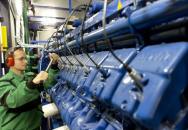ŠkodaPortal.cz Simply clever
ŠKODA plant Kvasiny: CO2 emissions lowered by 8,000 tons per year thanks to combined heat and power generation
09. 07. 2013
Kategorie: Společnost
Kvasiny, 10 July 2013 – Today, a new combined heat and power generation (CHP) facility was commissioned at the ŠKODA plant in Kvasiny. The new system decreases the CO2 emissions of the plant in Eastern Bohemia by ten percent or 8,000 metric tons of CO2 per year. The investments for the environmental measure amount to about three million EUR, the construction took seven months to complete. Two thirds of the invested amount was borne by ŠKODA, one third was financed by the Structural Fund of the European Union.
"The new combined heat and power generation facility makes the Kvasiny plant more environmentally friendly and is an important part of our sustainability strategy," says Michael Oeljeklaus, ŠKODA board member for Production and Logistics. Within the framework of 'GreenFuture' – which is part of the ŠKODA Growth Strategy 2018 – the Czech car maker wants to continue to enhance the sustainability of the company until 2018. Besides even more fuel-efficient vehicles, the focus is primarily on a more economical use of resources throughout the entire company. "We want to make our production 25 percent more environmentally compatible until 2018. The new CHP facility is an important contribution toward that goal," according to Oeljeklaus.
In combined heat and power generation, energy is only expended once for the simultaneous production of electricity and heat. Compared to procedures with a separate generation, this procedure significantly reduces energy consumption and thus CO2 emissions. The newly commissioned combined heat and power generation in Kvasiny saves 10 percent or about 8,000 metric tons of CO2 per year compared to the previous system of heat and power production. This amount of CO2 is equivalent to the incineration of about 300 rail cars of brown coal. "We use the waste heat generated during the generation of power for heating the paint shop," says Pavel Richter, the director of the ŠKODA plant in Kvasiny. "Apart from the environmental aspect, we are strengthening the energy independence of the production site," according to Richter.
The two facilities for the combined generation of heat and power produce 22,500 megawatt hours (MWh) of electric power per year and an equal amount of thermal output. Power and heat are generated through the burning of natural gas in a gas motor. The heat of the waste gases is used for heating the water of the heating system, while the mechanical energy from the motor drives the connected power-producing generator. Another benefit: "The new CHP facility was built in such as way that we are able to expand it in the future," says Richter.
ŠKODA has already had a positive experience with combined heat and power generation in the past as the manufacturer has been using this technology for the generation of power at the ŠKODA plant in Mladá Boleslav since August of 2012. The heating plant of the ŠKODA subsidiary ŠkoEnergo produces power for the vehicle production at the main plant of the manufacturer and, at the same time, serves as the heating plant for the city of Mladá Boleslav. Moreover, the heating plant increasingly utilizes biomass. By 2015, about one third of all the power generated is to be derived from renewable energies. In this way, ŠKODA wants to reduce the CO2 emission at the ŠkoEnergo heating plant by one fourth as compared to today.
By using the CHP technology in its plants, ŠKODA realizes another important step in the framework of the environmental strategy 'GreenFuture'. Its goals consist of improved economic results at a lowered burden for the environment. 'GreenFuture' rests on three pillars: 'GreenProduct', 'GreenFactory' and 'GreenRetail'. While the efficiency of the vehicles – less fuel consumption and thus fewer CO2 emissions – are the main focus of 'GreenProduct', a 25 percent reduction in the use of energy and water in particular, fewer emissions and increased recycling are the main focus of ŠKODA's production within the framework of 'GreenFactory'. The third pillar 'GreenRetail' focuses on sustainably operating dealerships and repair shops.
Environmentally friendly production and vehicles with efficient fuel consumption are a tradition at ŠKODA as evidenced by the current GreenLine and Green tec models of the Czech automobile manufacturer: at the present time, 65 ŠKODA models emit less than 120 grams of CO2 per kilometer, eleven emit less that 100 grams. The GreenLine version of the new ŠKODA Octavia generation is the most fuel-efficient Octavia ever – with a fuel consumption of just 3.3 liter diesel and CO2 emissions of no more than 87 gram per kilometer.
The Kvasiny plant is one of three ŠKODA production sites in the Czech Republic and employs approximately 4,500 people. The models ŠKODA Superb, ŠKODA Roomster and ŠKODA Yeti roll off its assembly lines. In 2012, the plant produced a total of 153,700 vehicles. A few days ago, ŠKODA began the production of the completely re-engineered Superb and Superb Combi in Kvasiny.
Podobné články

‘Birth Certificates’ for ŠKODA Classics
Mladá Boleslav, 24 July 2013 – ŠKODA offers a fantastic service for owners of historic ŠKODA vehicles. Proud owners of ŠKODA classics are able to…... Číst dále
Oblíbené články
Fresh, Modern, Simply Clever: The new face of the ŠKODA Dealer Network
Mladá Boleslav, 16 December 2013 – The fresh, new face of the future ŠKODA dealership network: The worldwide network…
Číst víceVirtual Tour of ŠKODA Museum and ŠKODA Customer Centre
Mladá Boleslav, 28 November 2014 – The ŠKODA Museum is living up to its reputation as an interactive world…
Číst více2013 ŠKODA bicycle collection now featuring 29-inch mountain bikes
Mladá Boleslav, May 28, 2013 – Boasting no less than ten new models, ŠKODA's 2013 bicycle collection is more…
Číst víceCopyright 2013, ŠkodaPortál.cz
